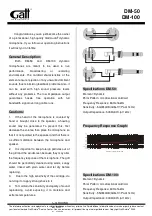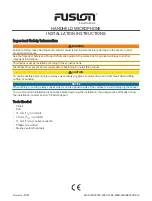
2
MODELS BG1.1 AND BG1.1K
UNIDIRECTIONAL DYNAMIC MICROPHONE
The Shure BG1.1 is a reliable, multi-purpose micro-
phone designed to perform in a variety of live music, sound
reinforcement, and basic recording applications. Its dy-
namic cartridge features a smooth frequency response
and a neodymium magnet for a high output level, while its
cardioid pattern ensures high gain-before-feedback, and
excellent isolation from undesired sound sources. The
BG1.1’s shock-mounting system, rugged cartridge
construction,
dent resistant steel ball grille, and sturdy die-
cast handle allow the BG1.1 to maintain its performance
through even the roughest environments. Typical applica-
tions for the BG1.1 include close-up vocals, instrument
pickup, public address, and Karaoke.
GENERAL RULES FOR MICROPHONE USE
1. For optimal signal-to-noise ratio, place the microphone
as close as practical to the desired sound source.
2. For the best gain-before-feedback and isolation from
undesired background noise, aim the microphone to-
ward the sound source and away from undesired sound
sources (see Figure 1). The BG1.1 features a cardioid
polar pattern which is most sensitive to sound directly
in front of the microphone, and least sensitive to sound
directly behind the microphone.
3. For the purest reproduction of sound, use no more than
one microphone per sound source and use the fewest
number of microphones necessary for the application.
4. For maximum isolation, keep the distance between mi-
crophones at least three times the distance from each
source to its microphone.
5. Work close to the microphone for extra bass response
(see Figure 2). This phenomenon is known as proximity
effect and can be used to achieve a fuller sound, espe-
cially for vocals during soft passages where extra em-
phasis is needed. For instruments, proximity effect can
be used to change bass output without using tone con-
trols.
6. Placing the microphone too close to acoustically reflec-
tive (smooth, hard) surfaces will result in a poor frequen-
cy response and will increase the chances for feed
back. To minimize this effect, place microphones as far
as possible from acoustically reflective surfaces.
7. Add an external windscreen when using the micro-
phone outdoors to reduce wind noise. The A58WS
windscreen is available in 7 different colors.
8.
Do not cover any part of the grille with your hand (see
Figure 3). Covering the grille alters the sound and dis-
torts the polar pattern, increasing the chances for feed-
back.
9.
It is important to keep foreign particles out of the grille
and the windscreen because they may alter the fre-
quency response of the microphone. The grille may be
periodically cleaned using warm, soapy water. Rinse
with plain water and let it dry before replacing.

































